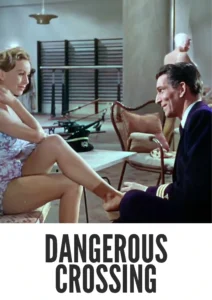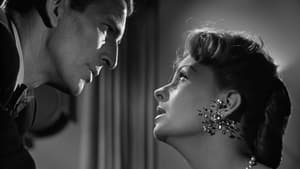Contact: [email protected]
Video Sources 0 Views
- Watch trailer
- Dangerous Crossing


Synopsis
Table of Contents
ToggleUnraveling Intrigue: Exploring “Dangerous Crossing” (1953) Review

Genre: Mystery/Thriller
Director: Joseph M. Newman
Cast: Jeanne Crain, Michael Rennie, Max Showalter
Introduction
“Dangerous Crossing” (1953) emerges as a gripping mystery thriller, immersing audiences in a tale of suspense, suspicion, and peril. In this exploration, we delve into the significance of the film’s early colored version and its enduring impact on cinematic storytelling.
Check The Full Colorized Movies List
Check Our Colorized Movies Trailer Channel
Understanding “Dangerous Crossing”: Director, Cast, and Genre
Under the direction of Joseph M. Newman, “Dangerous Crossing” features a stellar cast led by Jeanne Crain, Michael Rennie, and Max Showalter. Within the mystery/thriller genre, the film captivates viewers with its tense narrative, atmospheric setting, and compelling performances.
Exploring the World of “Dangerous Crossing”: Plot and Characters
Set aboard a luxurious ocean liner, “Dangerous Crossing” follows the harrowing journey of a newlywed bride whose life takes a sinister turn when her husband mysteriously disappears, leaving her to navigate a labyrinth of deceit and danger. With its intricate plot twists and suspenseful pacing, the film keeps audiences on the edge of their seats from start to finish.
The Art of Film Colorization
Film colorization serves as a transformative technique that breathes new life into classic works of cinema, enhancing their visual appeal and emotional resonance. In the case of “Dangerous Crossing,” colorization adds depth to the film’s atmospheric setting and heightens the tension of its suspenseful moments, offering viewers a fresh perspective on its timeless narrative.
Early Colored Films: A Brief History
The evolution of early colored films reflects a desire to innovate and captivate audiences with vibrant imagery and visual storytelling. From hand-tinted frames to advanced colorization techniques, filmmakers have embraced color as a means of enhancing the cinematic experience and immersing viewers in new worlds of imagination and wonder.
“Dangerous Crossing” and Its Early Colored Version
The decision to release “Dangerous Crossing” in a colorized format underscores a commitment to preserving its legacy and introducing it to new generations of viewers. By adding color to the film’s atmospheric setting and evocative imagery, filmmakers aim to captivate audiences with its timeless appeal and enduring suspense.
The Debate Over Film Colorization
The debate over film colorization remains a topic of discussion within the film community, with proponents and critics offering differing perspectives on its artistic merits and ethical implications. While some embrace colorization as a means of revitalizing classic works for modern audiences, others argue that it compromises the integrity of the original film and undermines the filmmaker’s vision.
Examining “Dangerous Crossing” as an Early Colored Film
As we examine “Dangerous Crossing” in its early colored version, we are greeted with a visual feast of vibrant hues and stunning cinematography. The addition of color enhances the film’s atmospheric setting and evocative imagery, immersing viewers in its suspenseful narrative and heightening the tension of its gripping moments.
Influence and Legacy: “Dangerous Crossing”‘s Impact on Cinema
“Dangerous Crossing” has left an indelible mark on the world of cinema, inspiring countless filmmakers and captivating audiences with its suspenseful narrative and compelling characters. Its enduring legacy can be seen in subsequent works that draw inspiration from its themes of deception, danger, and moral ambiguity.
Director’s Cinematic Legacy: Beyond “Dangerous Crossing”
Joseph M. Newman’s directorial legacy extends far beyond “Dangerous Crossing,” encompassing a diverse body of work that spans multiple genres and styles. From suspenseful thrillers to thought-provoking dramas, Newman’s films resonate with audiences on a profound level, exploring the complexities of the human condition with depth and authenticity.
Themes Explored in “Dangerous Crossing”
“Dangerous Crossing” explores a myriad of themes that resonate with audiences of all ages, from the nature of trust and betrayal to the consequences of obsession and manipulation. At its core, the film delves into the darkest corners of the human psyche, exposing the lengths to which individuals will go to protect their secrets and achieve their goals.
Reception and Controversy Surrounding “Dangerous Crossing”
Upon its release, “Dangerous Crossing” received widespread critical acclaim, earning praise for its suspenseful narrative, atmospheric setting, and compelling performances. Audiences were captivated by its gripping storyline and unpredictable plot twists, cementing its status as a classic of the mystery/thriller genre.
Where to Watch “Dangerous Crossing” Online
For viewers eager to experience the suspense of “Dangerous Crossing,” the film is readily available on popular streaming platforms. Whether in its original black-and-white format or early colored version, audiences can immerse themselves in the film’s tense narrative and atmospheric setting.
FAQs About “Dangerous Crossing”
1. Why was “Dangerous Crossing” chosen for colorization?
- The decision to colorize “Dangerous Crossing” was driven by a desire to introduce classic films to new audiences and showcase their enduring appeal. Additionally, colorization aimed to enhance the film’s visual impact and immerse viewers in its atmospheric setting.
2. Does colorization alter the integrity of the original film?
- Colorization has been a subject of debate within the film community, with some arguing that it compromises the artistic integrity of the original work. However, proponents contend that colorization offers a new perspective on classic films without detracting from their inherent value.
3. How does colorization impact the viewing experience of “Dangerous Crossing”?
- Colorization adds depth and vibrancy to “Dangerous Crossing,” enhancing its visual appeal and emotional resonance. While some may prefer the classic black-and-white aesthetic, colorization offers a fresh interpretation of the film’s timeless narrative and enduring suspense.
4. Is the original black-and-white version still available for viewing?
- Yes, the original black-and-white version of “Dangerous Crossing” remains accessible to viewers who prefer to experience the film in its intended format. Many streaming platforms offer both the colorized and original versions, allowing audiences to choose according to their preferences.
5. How does colorization impact the film’s historical accuracy?
- Colorization can enhance the visual authenticity of historical settings, providing viewers with a more immersive experience. However, it is essential to acknowledge that colorization is an interpretive process and may not always accurately reflect the historical context of the film.
6. Are there any significant differences between the colorized and original versions of “Dangerous Crossing”?
- While the core narrative remains unchanged, colorization introduces subtle differences in visual aesthetics and atmosphere. Certain scenes may evoke different emotions or highlight previously unnoticed details, offering viewers a fresh perspective on the film’s themes and characters.
7. How has the reception been to the colorized version of “Dangerous Crossing”?
- Reception to the colorized version of “Dangerous Crossing” has been mixed, with some audiences embracing the enhanced visual presentation and others expressing reservations about altering a classic film. Ultimately, individual preferences and opinions shape the overall reception of the colorized version.
8. Will other classic films receive similar colorization treatments in the future?
- The decision to colorize classic films depends on various factors, including audience demand, technological advancements, and preservation efforts. While some films may benefit from colorization, others may remain untouched to preserve their original artistic vision.
Conclusion
“Dangerous Crossing” stands as a timeless masterpiece that continues to captivate audiences with its gripping storyline, unforgettable performances, and atmospheric cinematography. Whether experienced in its original black-and-white format or early colored version, the film’s enduring allure and suspenseful narrative resonate with viewers of all ages, reaffirming its status as a classic of the mystery/thriller genre. As we unravel the mysteries of this captivating film, we are reminded of the enduring power of storytelling and the timeless appeal of cinema.











